There used to be a time, not too long ago, when 35mm lens choices for Sony full frame were slim pickings.
We had the tiny Sony Zeiss 35mm f/2.8 cupcake lens which launched with the original Sony a7, then you had the large, heavy and expensive Sony Zeiss 35mm f/1.4, then you had the even larger and heavier Sigma 35mm f/1.2 DG DN.
And that was pretty much it. Everyone and their grandma were asking Sony to hurry up with a lightweight 35mm f/2 or 35mm f/1.8.
Preferably with the Sonnar rendering of the superb Zeiss 35mm f/2 on the fixed-lens Sony RX1.
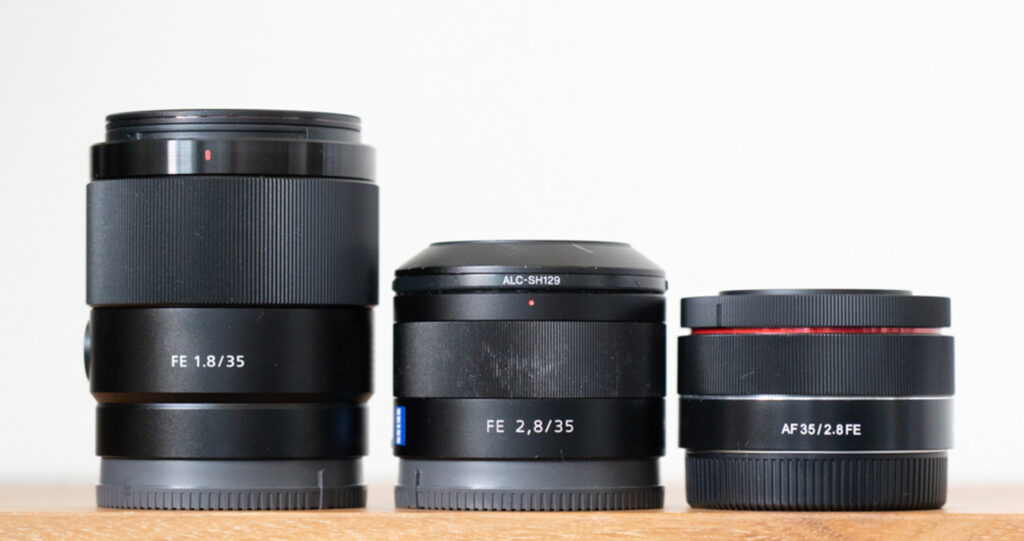
It took Sony a few years, but our wish was finally answered when Sony finally delivered this lens – the Sony FE 35mm f/1.8. (Check current street price on Amazon)
I’ve had this lens for almost 4 years now, and it remains one of my most used lenses for Sony full frame. It’s small enough to carry everywhere, and at f/1.8, it’s more than fast enough for almost any situation.
Funny enough, after the release of this lens, it was like a flood gate opened, and more than a few excellent 35mm lenses were released, one after the other. Just some of the notable ones:
- Sigma 35mm f/2 DG DN Contemporary: an absolute joy to use. If you care about hand feel, and having an aperture ring, this is the one to get. It’s slightly larger than the Sony, slightly worse AF since it has a stepping motor (vs the linear motor on the Sony). But, boy, is it a joy to shoot with, if you care about having an aperture ring and metal barrel.
- Samyang 35mm f/1.8 AF: This affordable prime lens from Samyang, (it is sometimes branded as Rokinon – but it’s the exact same lens as a Samyang), is the one to get for those on a tight budget. A clear step up from the earlier Samyang autofocus efforts, this lens is cheap, light, and gets you 90% of what the Sony does, for a fraction of the price. I would rate the AF on this one as slightly better than the Sigma.
- Sony 35mm f/1.4 GM: The crème de la crème of 35mm lenses for Sony E mount. It’s larger than any of the above, but it’s still fairly small for what it is. It’s one of the smallest AF 35mm f/1.4 lenses for any system. It features Sony’s latest XD linear AF motors, so it’s got the snappiest AF out of all 35mm lenses for Sony right now, especially for moving subjects. But, it’s still bigger and heavier than the f/1.8 or f/2 options, and it is pricey.
- Sigma 35mm f/1.4 DG DN: The DN version of the Sigma 35mm is Sigma’s first built for mirrorless 35mm lens with an f/1.4 aperture. Coming it at almost the same price as the FE35, it can be a good value if you really want that f/1.4 aperture. But, there are some caveats here – it’s bigger and heavier than the Sony 35mm f/1.4 GM, and it still features Sigma’s stepping AF motor (unlike the Sigma 50mm f/1.4 DG DN which gets Sigma’s latest linear AF motor). Most people who need the f/1.4 aperture pony up for the Sony GM instead.
But, let’s talk about the Sony FE 35mm f/1.8 *(aka Sony FE35), and why I think it’s the best 35mm option for Sony, for most people.

Build Quality and Handling
Build quality and hand feel is pretty good, it doesn’t feel as good as the Sigma 35mm f/2, but the Sony FE 35mm f/1.8 is a solidly built lens.
The lens barrel is made of aluminum and high quality plastic. There is a weather sealing gasket on the lens mount, and there are several other seals around the lens. Sony doesn’t claim weather-sealing, but they do say the lens is sealed against dust and moisture.
I’ve used mine in a lot of light rain, including getting caught in some tropical rain showers in Asia, and I haven’t had any problems. But, of course, this is one of those things where YMMV.
The lens barrel is a bit sparse on features, but this is the same as all other non-G and non-GM Sony lenses.
There is a customizable button, which defaults to a focus hold button. This means you can use it to lock focus in situations where the subject moves in and out of focus plane or when you don’t want the focus to get distracted by foreground elements or other movement in front of the subject.
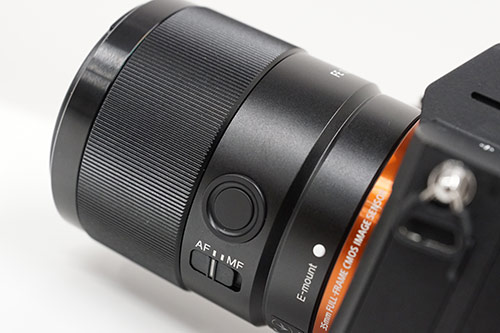
Personally, given the excellent AF tracking in most Sony cameras, I like using the custom button as a manual focus switch instead. Yes, there is a separate AF-MF switch on the lens, but I prefer using the custom button.
Using the button means I don’t have to adjust my grip on the lens, or take my eye away from the viewfinder when I need to quickly switch to MF. I find this faster than using the dedicated AF-MF switch. In this way, it sort of operates like a poor man’s Leica Q.
Aside from that, there are no other buttons on the lens.
More disappointing perhaps, is the lack of an aperture control ring.
If you want a dedicated aperture ring, you’d have to look at the Sigma 35mm f/2 DG DN, or move up to the Sony 35mm f/1.4 GM or the Sigma 35mm f/1.4 DG DN.
Sony does supply a decent petal lens hood made of plastic. It’s nice, feels a bit cheap, but it does the job. More importantly, it’s not too big. It can easily reverse on the lens, for storage.
The lens has 55mm filter threads. A bit annoying, since it’s an atypical size, but 55mm filters are still easily available.
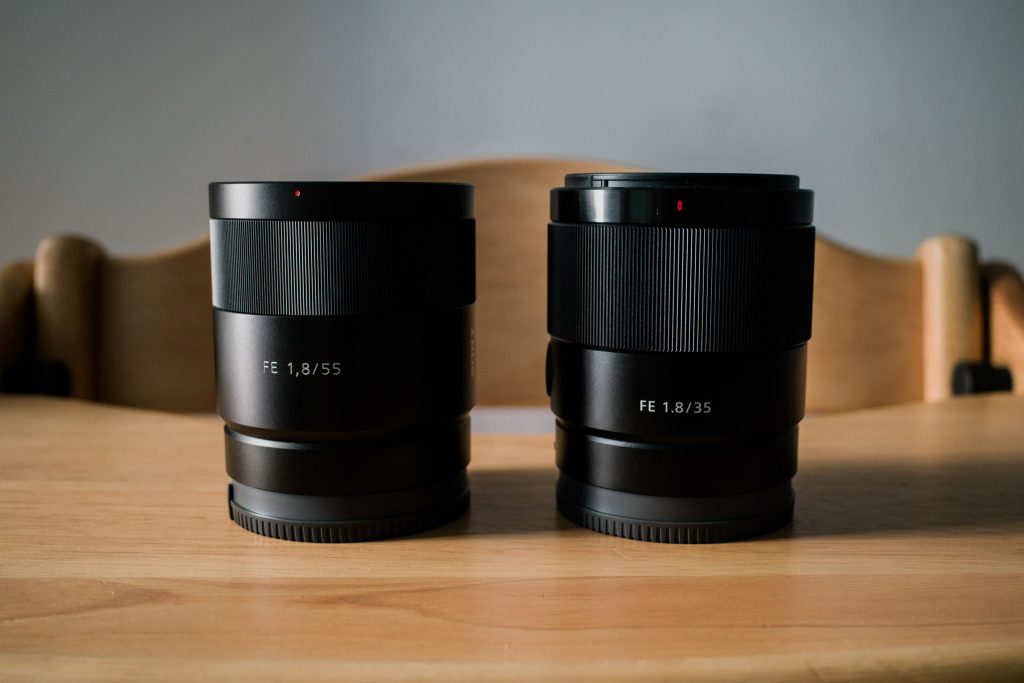
Above, you can see the FE35 next to a lens that most people have probably used or owned at one time or another, the Sony Zeiss FE 55mm f/1.8.
Size and Weight
The Sony FE 35mm f/1.8 weighs just 280 grams, which is pretty lightweight for a full frame lens.
It’s a mere 71mm or 2.8 inches in length, so it’s not a beast to carry around.
Paired with a compact body like the Sony a7c II, you’re at just under 900 grams, including weight of the class-leading FZ-1000 battery. That’s still heavier and the lens is still longer than a Leica Q3, but, you’re spending many thousands less and you have the benefit of being able to change lenses.
Because of it’s “just right” field of view, a 35mm lens is generally considered a do-it-all lens. An everyday carry (EDC) lens. A snapshot lens. But, that really means nothing if it’s not easy to carry around.
The FE35 is small enough to be an everyday carry, and fast enough to get you blurry backgrounds and to shoot in low light. A lot of times, when you put a premium on size and weight, you know you’ll have to give up speed and ability to blur backgrounds, but here, you’re not really giving up anything – all for a mere 280 grams and 71mm in length.

Manual Focus experience
The focus ring is broad, nice to the touch, and more importantly is smooth and precise, allowing for easy manual focusing when necessary.
It also has a linear focus response. Something that I found very surprising. It’s a great feature for video shooters.
It’s not very well dampened. If you were expecting a real MF experience, this isn’t it. But it’s also not like the usual, disconnected manual focus feel that you get in a lot of mirrorless AF lenses from other brands.
It’s light to the touch, yet capable of precise adjustments.
I think this is by design, as it’s largely similar to most Sony lenses. My guess is this is a nod to video creators. This ‘light yet precise’ approach (vs the typical heavy dampening that you get with real manual focus coupling) will allow for easy, yet precise, adjustment of the focus ring even with a single finger, even when mounted on a motorized gimbal, for example.
But, it’s also great for stills. It doesn’t have the ‘disconnected’ feel of a lot of manual focus systems in AF lenses. In the shot below, I had to use MF as I was shooting through a closed window in a moving car, with rain drops on the glass.

Image Quality and Sharpness
No complaints here. And, I know it’s all the rage these days, but honestly, sharpness is one of the least important factors in any modern lens for me. Pretty much any lens made in the last 10-15 years is pretty damn sharp, unless specifically designed to not be sharp!
But, with that said, yes, this is a damn sharp lens. Even wide-open. In fact, I wish it were less so, when wide-open. Sharpness is good if you crop a lot, but in some situations, I find myself massaging the files a bit more for people shots just to take some of the digital edge off. But, that’s my preference, as I prefer a slightly filmic softness to my images.

Chromatic Aberration and Vignetting
The Sony FE 35mm f/1.8 lens does an impressive job at minimizing chromatic aberration, ensuring that color fringing is kept to a bare minimum. Lateral CA’s do show up in uncorrected raw files, but I’m not one of those purists who don’t like auto-corrections. LoCA is present at f/2.8 and wider, which can be a problem in some situations, and it sometimes adds to the impression that the lens has busy bokeh, but it’s not something that shows up in most shots.
Additionally, vignetting is fairly well-controlled. There is some slight darkening at the corners when shooting wide open, and doesn’t quite disappear even when stopped down. But it’s not a big issue for me, and the way I use this lens (as a documentary, travel, street photography lens). Maybe if I were a serious landscape shooter, it would bother me, but then again, I don’t think most serious landscape shooters would be looking at a 35mm lens.

Bokeh and Background Blur
The Sony FE 35mm f/1.8 lens is capable of producing beautiful background blur or bokeh. The nine-blade aperture diaphragm helps with this.
It’s not perfect, and it’s not as good as the 35mm lens on the Sony RX1, unfortunately. If you’re looking for an RX1 like rendering, this isn’t it. It gets you close, but the transition zones just are not as nice and the bokeh is slightly harsher looking especially in busy backgrounds. But, that’s in certain circumstances only. In most circumstances, both background and foreground blur is pretty pleasing.
But, there is plenty of pop. In certain situations, it’s hard to see the difference between this and the 35mm GM, for example.

Autofocus Performance of Sony FE 35mm f/1.8 lens
Not much to report here. It’s a Sony lens, after all.
The autofocus of this lens is fast and accurate and near instantaneous on most situations, all thanks to the linear motor that drives the focus mechanism.
The motor is also almost silent, making it great for video, and the focus is internal, so the front element doesn’t rotate.
It doesn’t have Sony’s latest XD linear motors, which they put on all their lenses now, but it’s still plenty fast.
It’s fully capable of taking advantage of Sony’s real time tracking AF, which is one of the main reasons why a lot of people use Sony.
It’s also one of the Sony lenses capable of keeping up with the Sony a9’s 20fps or the Sony a1’s 30fps continuous shooting, with full autofocus and autoexposure.
Just for comparison, most third party lenses, such as Sigma lenses, are limited to 15fps or less.
The very popular Sony Zeiss 55mm f/1.8, for example, is not capable of doing 20fps and 30fps on the Sony a9 and a1. Same with the Sony Zeiss 35mm f/2.8 and the Sony FE 28mm f/2. These are all limited to a max of 15fps on both the Sony a9 and a1.
Now, these aren’t really sports focal lengths. And 15fps is more than fast enough for a lot of subjects, but it is something to keep in mind.
In low-light, there is a very slight dip in performance, but it’s hardly noticeable. Sony remains one of the best in low light AF, and this lens takes full advantage of that.
The AF performance makes this an excellent lens for both still photography and video work. The autofocus transitions smoothly between subjects without any hunting or noise.
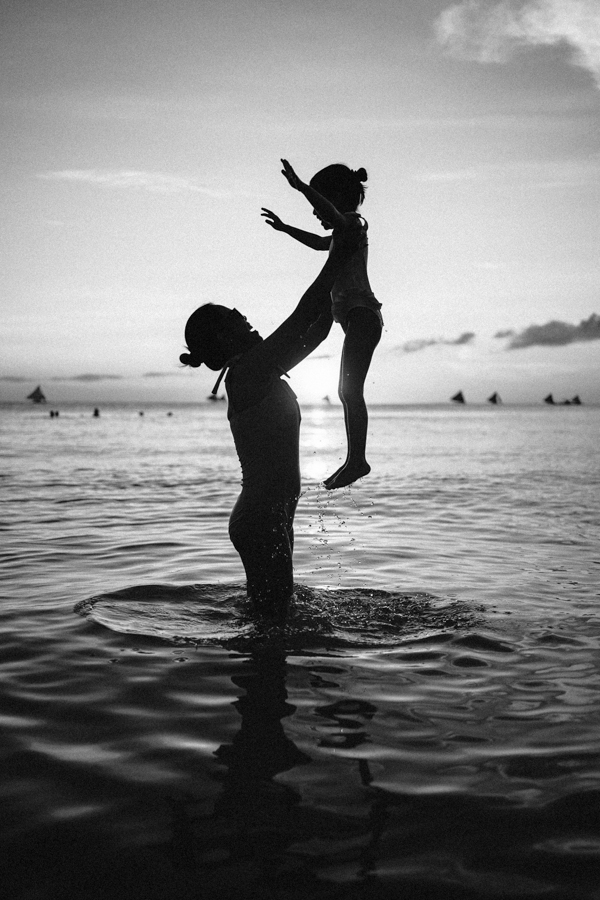
Close focusing
The close focusing capabilities are also pretty good (0.22 meters) and the lens has no trouble moving from close focus to infinity and back.
The close focusing is one of the biggest advantages of this lens vs most other 35mm lenses for Sony. I find that this adds to the versatility of this lens. It can easily do double duty for shooting close-up details – food, patterns etc.. No, it’s not a macro lens (max. magnification is only 0.24x), but for a 35mm lens, it’s pretty damn good.
The close focusing also comes in useful in social settings. Even with my kid running towards the camera and making funny faces, the lens is able to nail focus where most lenses in this focal length would struggle.

Conclusion: Is it the best 35mm lens for Sony full frame?
It’s the best for most people.
If you want the absolute best, maybe pay up for the Sony 35mm f/1.4 GM.
But, the Sony 35mm f/1.8 lens will get you most of the way there.
Sony has done a good job in creating a lens that’s reasonably priced, performs great optically, has fast and accurate AF, great close focusing while being well built yet lightweight. It gives up some features (e.g. aperture ring, the latest XD linear motors), but it still give you the essentials like an AF-MF switch, a customizable button and weather sealing. Not to mention practically no focus breathing, especially when compared with the 35mm f/1.4 GM.
Unless you don’t care about price or weight or size, any lens purchase is about finding the perfect balance for our needs.
And once you factor in price to performance, the Sony FE 35mm f/1.8 is pretty hard to beat. Sure, it’s not an f/1.4 lens, but it’s good enough for most situations. And as the video below will show, it’s pretty hard to see the difference between f/1.8 and f/1.4 in a lot of situations, unless you’re specifically doing side by side tests.
To me, a 35mm lens on a full frame camera is all about versatility. It’s an everyday focal length. So, it needs to be small enough, light enough, and optically good enough to keep up with most situations.
The FE35 does that, and does that better than most other options. The AF can keep up with my kids better than third party lenses, and it’s significantly smaller and cheaper than the 35GM. It doesn’t feel like a lump to carry around everyday. Especially when paired with a Sony a7c or a7c II, it’s not really a set-up I have to ‘think about’ bringing with me. It’s easy enough to just sling on one shoulder and go out the door.
If you’re not really a one-lens only person and you always carry a camera bag, the FE35 makes for a great combo with the Sony FE 85mm f/1.8. With a combined weight of under 700 grams, this is a great 1-2 punch of f/1.8 lenses that won’t break the bank and your shoulders or back.
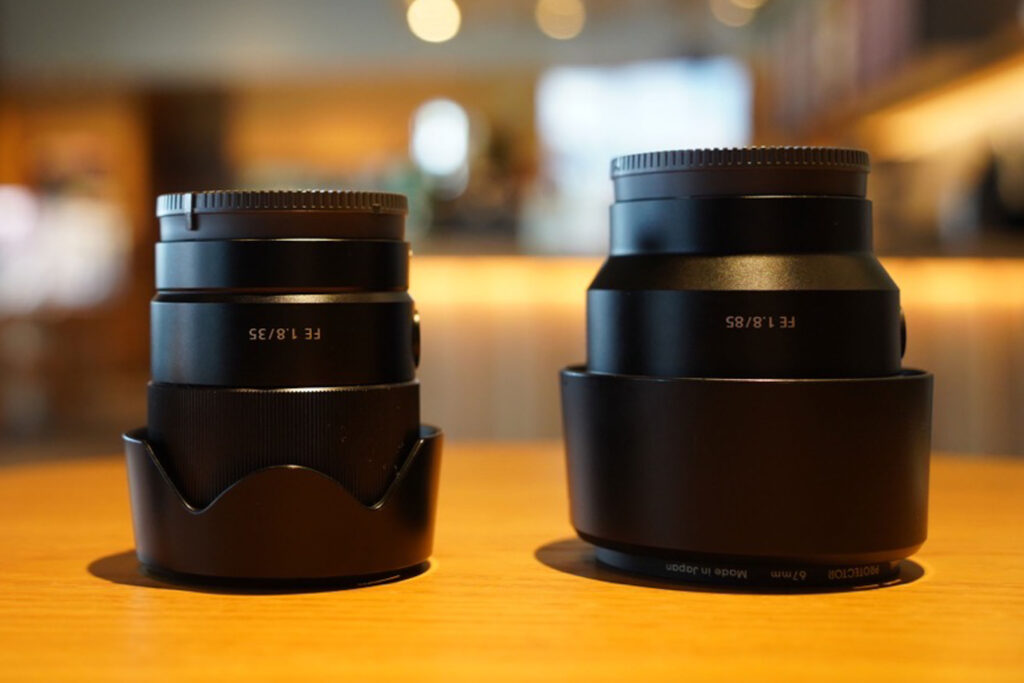
If you want even smaller, you can get the Sigma 90mm f/2.8 DG DN as a great short-tele option. For wider, you can grab the compact Sony 24mm f/2.8 G lens. You can also look at our guide to the Smallest lenses for Sony Full Frame Cameras.
Once you factor all that in, it’s pretty hard to argue against this lens. Lens design is all about compromises, and Sony definitely made the right compromises here, delivering an almost perfect everyday carry 35mm lens. It’s what you would call a “well-balanced” lens. And if you put a premium on size and weight like I do, it’s an exceptional value.
Check out the current street price of the Sony FE 35mm f/1.8 lens on Amazon. NOTE: Don’t confuse this lens with the Sony E 35mm f/1.8 OSS lens. That’s a different lens designed for APS-C cameras and won’t give you a 35mm on full frame.



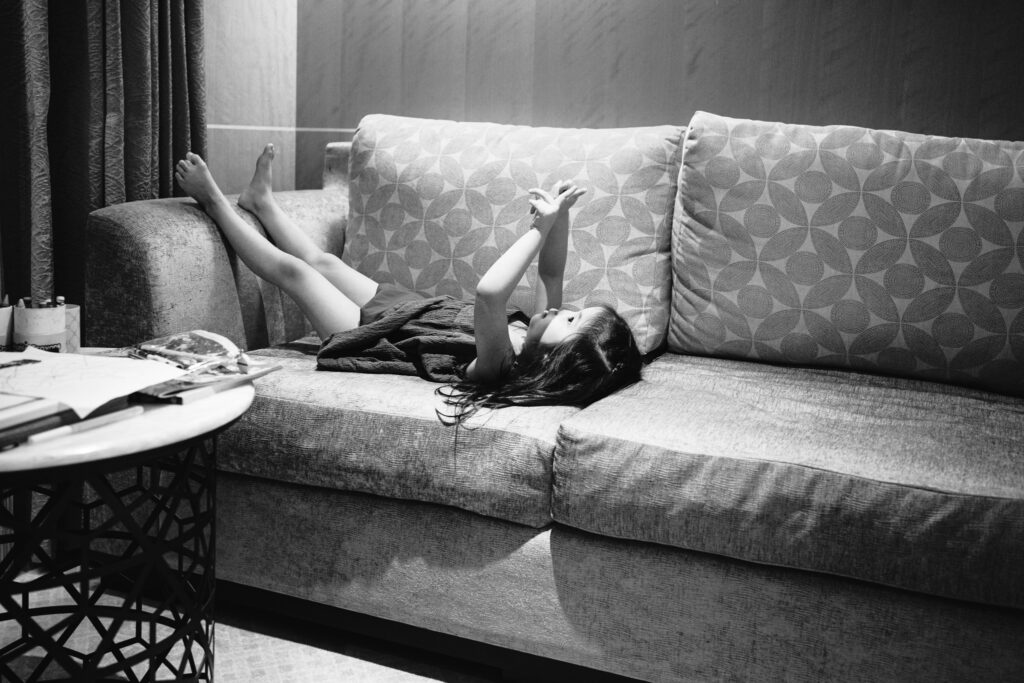
Could you offer your perspective on this lens versus the Sony 40mm f2.5 G?
The 40mm is smaller and lighter but it doesn’t open up to f1.8. I’m curious to hear your perspective on them.
I had considered maybe getting the 35mm GM and the 40mm as my everyday carry.
Alternatively, stick with just the Sony 35mm FE 1.8.